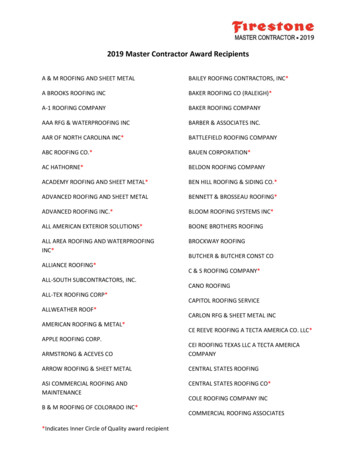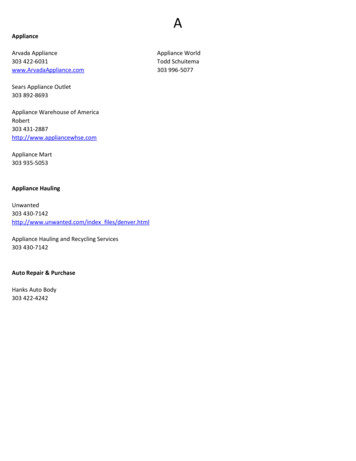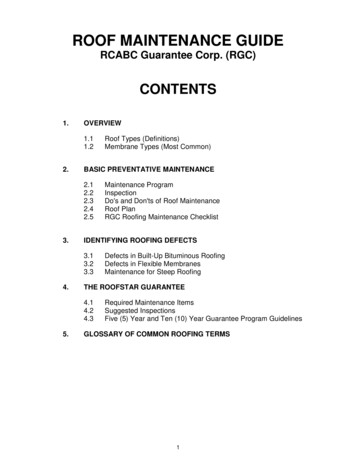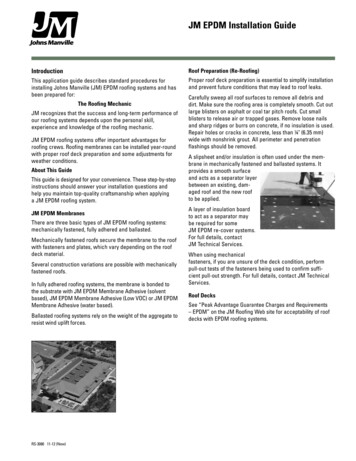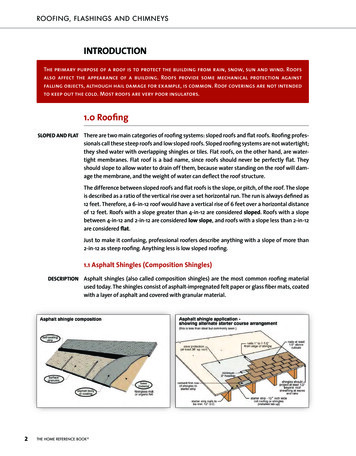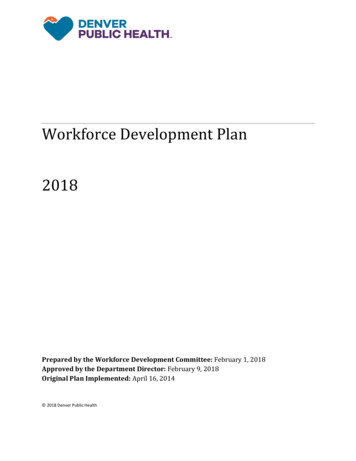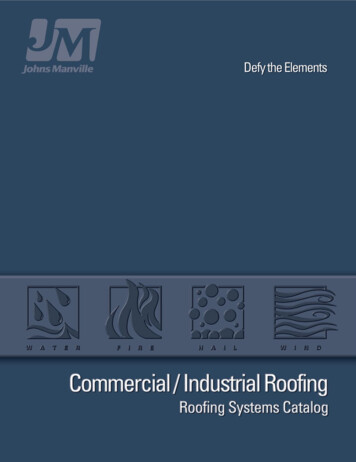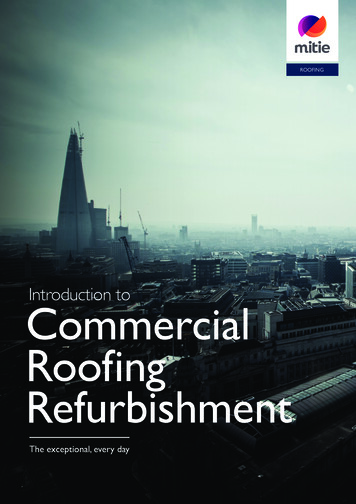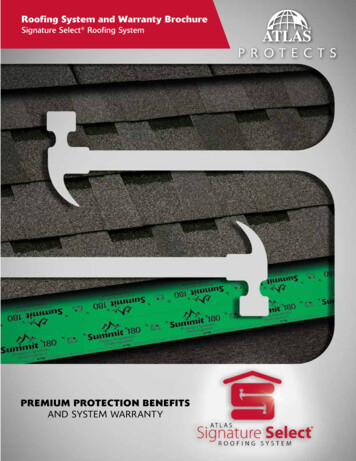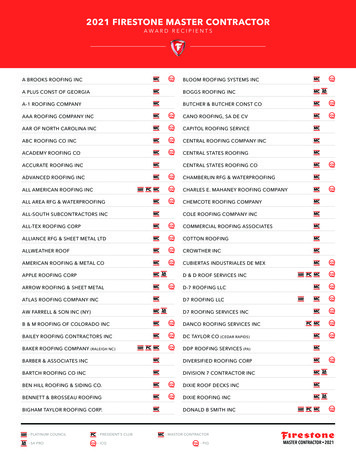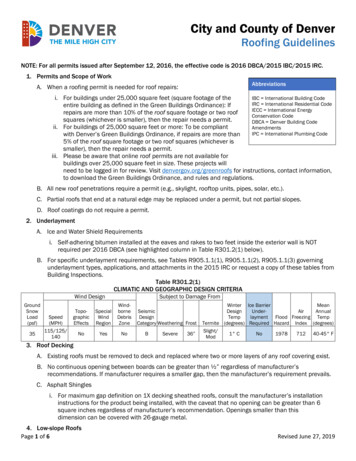
Transcription
City and County of DenverRoofing GuidelinesNOTE: For all permits issued after September 12, 2016, the effective code is 2016 DBCA/2015 IBC/2015 IRC.1. Permits and Scope of WorkAbbreviationsA. When a roofing permit is needed for roof repairs:IBC International Building Codei. For buildings under 25,000 square feet (square footage of theIRC International Residential Codeentire building as defined in the Green Buildings Ordinance): IfIECC International Energyrepairs are more than 10% of the roof square footage or two roofConservation Codesquares (whichever is smaller), then the repair needs a permit.DBCA Denver Building Codeii. For buildings of 25,000 square feet or more: To be compliantAmendmentsIPC International Plumbing Codewith Denver’s Green Buildings Ordinance, if repairs are more than5% of the roof square footage or two roof squares (whichever issmaller), then the repair needs a permit.iii. Please be aware that online roof permits are not available forbuildings over 25,000 square feet in size. These projects willneed to be logged in for review. Visit denvergov.org/greenroofs for instructions, contact information,to download the Green Buildings Ordinance, and rules and regulations.B. All new roof penetrations require a permit (e.g., skylight, rooftop units, pipes, solar, etc.).C. Partial roofs that end at a natural edge may be replaced under a permit, but not partial slopes.D. Roof coatings do not require a permit.2. UnderlaymentA. Ice and Water Shield Requirementsi. Self-adhering bitumen installed at the eaves and rakes to two feet inside the exterior wall is NOTrequired per 2016 DBCA (see highlighted column in Table R301.2(1) below).B. For specific underlayment requirements, see Tables R905.1.1(1), R905.1.1(2), R905.1.1(3) governingunderlayment types, applications, and attachments in the 2015 IRC or request a copy of these tables fromBuilding Inspections.Table R301.2(1)CLIMATIC AND GEOGRAPHIC DESIGN CRITERIAWind bject to Damage brisZoneNoYesNoSeismicDesignCategory Weathering FrostBSevere36”Winter Ice BarrierMeanDesignUnderAirAnnualTemplayment Flood Freezing TempTermite (degrees) Required Hazard Index (degrees)Slight/1 CNo1978712 40-45 FMod3. Roof DeckingA. Existing roofs must be removed to deck and replaced where two or more layers of any roof covering exist.B. No continuous opening between boards can be greater than ½” regardless of manufacturer’srecommendations. If manufacturer requires a smaller gap, then the manufacturer’s requirement prevails.C. Asphalt Shinglesi. For maximum gap definition on 1X decking sheathed roofs, consult the manufacturer’s installationinstructions for the product being installed, with the caveat that no opening can be greater than 6square inches regardless of manufacturer’s recommendation. Openings smaller than thisdimension can be covered with 26-gauge metal.4. Low-slope RoofsPage 1 of 6Revised June 27, 2019
City and County of DenverRoofing GuidelinesA. Membrane roofs must be installed by a D-Roof Covering/Waterproofing licensed contractor.B. If membrane is less than 10% of the entire roof or two roof squares (whichever is smaller), it can beinstalled by a D-Roof Shingles licensed contractor on shingle projects that have some low-slope areas(porches and patios, for example).5. Wind Speed RequirementsA. Wind Resistance of Asphalt Shingles (per the 2015 IRC - Section R905.2.4.1)i. All shingles shall be tested and labeled to comply with the requirements of ASTM D 7158.ii. If the brand of shingles is not included in the scope of ASTM D 7158, then the shingles must betested and labeled to comply with ASTM D 3161.B. Wind Speed Zones for Denver (per the 2015 IBC Section 1609)i. Areas east of Federal Blvd. – 115 mph min. ratingii. Federal Blvd. to Sheridan Blvd. – 125 mph min. ratingiii. Sheridan Blvd. to Kipling St. – 140 mph min. rating6. Attic VentingA. New Construction (per the 2015 IRC Section R806 Roof Ventilation)i. Unvented attic assemblies require air-impermeable insulation (minimum of R-20, per IRC R.806.4).The total insulation R-value must meet 2015 IECC.B. Re-roofing Existing Constructioni. Venting is not inspected on re-roof projects, if the venting meets the building code in effect at thetime of original construction.ii. Optional: Venting can be added to meet manufacturer’s warranty requirements, as permanufacturer’s installation instructions.7. Energy Code RequirementsA. New roofs must comply with the 2015 IECC.B. Existing roofs without insulation in the cavity and where the sheathing or insulation is exposed duringreroofing shall be insulated either above (R-30ci) or below (R-38 Flat/R-49 Attic) the sheathing.8. Asbestos: Must follow the Colorado Department of Public Health and Environment’s (CDPHE) requirementsfor a certified asbestos inspection and removal and may be required to show proof of the inspection.9. Inspections Required for Roofing and Siding PermitsUse the “205,” “206,” or “201” inspection code when requesting an inspection by phone at 720-865-2501.206 – Other205 – Pre-Inspection201 – Roof3-Digit Inspection Code and Type of(Mid-roof, RoofCommercial(Final)Roof SystemInsulation, Meeting)(New or Re-roof)One- and Two-Family Asphalt ShinglesNoIf Needed*YesTownhomesYesIf Needed*YesCommercial Asphalt ShinglesYesIf Needed*YesLow-slope RoofsYesIf Needed*YesTileNoYesYes*A mid-roof inspection may be required when the pre-inspection identifies items that need to be completedbut will not be visible for inspection at the final.Page 2 of 6Revised June 27, 2019
City and County of DenverRoofing Checklist#PASS2015IRC/IBC2016 DBCAChapterSectionFAILBuilding CodeGeneral Roof and Re-roof Requirements1IRC R903.1IBC 1503.1General2IRC R908.2IBC 1511.2Structural andStructural roof components shall support the roof covering system and theconstruction loads materials and equipment loads encountered during installation.3IRCRoof replacementR908.3.1.1(3)IBC 1511.3.1.1Existing roof covering must be removed down to deck unless re-covering a singlelayer.4IRC R903.2IBC 1503.2FlashingFlashing shall be installed to prevent moisture from entering the roof and wall.Pitch pansRequired if multiple penetrations are intended to be flashed together, or forequipment support legs.Duct and pipejacksPipe and duct penetrations shall be flashed using roof flashing (jacks) intendedfor the specified roof system.Flues/ductsB-vent pipes must have a metal boot of the same gauge of the pipe and have astorm collar installed to protect the metal boot to pipe connection. Vent capsshall be in good shape and fitted for proper venting.567Manufacturer’s installation instructions are included as part of the IBC and IRC.8IRC R903.2.1IBC 1503.2.1LocationsFlashing shall be installed at wall and roof intersections, change in roof slopes,and roof openings.9IRC R903.2.2IBC 1503.2.2Crickets andsaddlesAll vertical projections on sloped roofs greater than 30” require a cricket orsaddle made of sheet metal or of the same material as the roof covering.10DBCA R903.2.3 FlashingSingle-plyFlashing for single-ply roof systems shall be installed per manufacturer’s currentrecommendations.IRC R908.5Reinstallation ofmaterialsExisting flashings shall be replaced where rusted, damaged, or deteriorated.IRC R903.3IBC 1503.3CopingParapet walls shall be properly coped with non-combustible, weatherproofmaterials of a width not less than the thickness of the wall and be sealed atevery joint with an overlap of no less than 2”.IRC R903.4Roof drainageUnless roofs are sloped to drain over roof edges, roof drains shall be installed ateach low point on the roof.IRC R903.4.1IBC 1503.4.1Secondary drainsor scuppersWhere roof drains are required, secondary (overflow) drains and scuppers arerequired where parapets are present and entrapped water cannot drain whenprimary drains back-up. Overflows shall be the same size and installed 2” abovethe main drain. The installation and sizing of the drains shall comply with the IPC.Overflow drains cannot connect to the primary drain.IBC 1503.4.2ScuppersEmergency overflow scuppers shall be sized and located to prevent the depth ofponding water from exceeding the designed roof load. Scuppers shall have aminimum 4” opening.1112131415161718IRC R908.1(2)IBC 1511.1(2)For roofs that provide positive drainage, re-covering or replacing an existing roofcovering shall not require the secondary (emergency overflow) drains or scuppersof Section R903.4.1 to be added to an existing roof.DBCA R903.4.2 Equipment on roof Equipment on the roof shall be installed on 8” legs bearing on decking or be& 1503.2.2installed on an 8” curb bearing on decking which can be flashing in properly.Placing the equipment on resonator pads or slip sheets is not allowed.IRC R905.1.1Page 3 of 6UnderlaymentMust meet the specifications in Tables R905.1.1(1), (2), and (3) regardingunderlayment types, application, and attachment.Revised June 27, 2019
City and County of DenverRoofing Checklist#19PASS2015IRC/IBC2016 DBCAChapterSectionDBCA R903.2.6 Stucco& 1507.10.5FAILBuilding CodeExterior wall finishes must terminate a min. of 8” above the finished roof of alow-slope roof or a min. of 2” above a shingle, shake, or tile roof.Asphalt Shingle Roof Requirements20IRC R905.2.1SheathingRoof decking shall be solidly sheathed (new construction only).21IRC R905.2.2IBC 1507.2.2SlopeAsphalt shingles shall be used only on roof slopes of 2:12 or greater. For slopes2:12 up to 4:12, double underlayment is required. (See underlayment tables:Tables R905.1.1(1), R905.1.1(2), R905.1.1(3) in the 2015 IRC.)22232425IRC R905.2.4.1 Wind resistanceAsphalt shingle classification shall be ASTM D 7158 D, G or H depending on windzone.IRC R905.2.6As required by manufacturer or minimum of four nails per shingle for all roofslopes up to 21:12.AttachmentIRC R905.2.8.2 ValleysAll materials must comply with the ASTM’s listed in R905.2.8.2.IBC 1507.2.9.2 (1) Open metalOpen valleys lined with metal shall be a minimum of 24” wide and corrosionresistant.2627(2) Open rollOpen valleys lined with two plies of rolled roofing shall be permitted where thebottom layer is at least 18” wide and the top layer is at least 36” wide.(3) Closed rollClosed valleys shall be a minimum of 36” wide of either 1) one ply of smooth rollroofing or 2) self-adhering modified bitumen.(3) Closed metalMetal is not allowed in a closed valley.28DBCAR905.2.8.229IRC R905.2.8.3 Sidewall flashing:Headwall303132Continuous flashing shall be a minimum of 4” x 4” and all flashing shall becounter flashed with metal or exterior finish and properly sealed.StepStep flashing shall be a minimum of 4”x 4” piece per shingle, and all flashingshall be counter flashed with metal or exterior finish and properly sealed.Kick-outsKick-outs at the end of the sidewall step flashing shall be turned out in a mannerthat directs water away from the wall onto the roof or into a gutter.IRC R905.2.8.4 Other flashingFlashing against a vertical wall, soil stack, vent pipe and chimney.IRC R905.2.8.5 Drip edgeIBC 1507.2.9.3Drip edge shall be provided at eaves and rake edges: Installed with a minimum of 2” overlap for segments, extend a minimum of¼” below roof sheathing and a minimum of 2” onto roof deck; Mechanically fastened at a minimum of 12” o.c.; and Underlayment shall be installed over drip edge along eaves and under dripedge along rakes.33Low-slope Roof Requirements34DBCA 140.7Other inspectionsAll commercial roofs require a “205 - Pre-Inspection Commercial” inspection.DBCA R905.5.2 Deck slope90 lb. roll roofing shall not be applied to roof slopes less than 2:12. Exception:Detached garages, patios and carports open on three sides may have a slope of1:12.Slope36IRC R905.1113.1IBC 1507.1113.1Modified Bitumen, Thermoset (EPDM), and Thermoplastic (TPO/PVC) shall have aminimum design slope of ¼:12 for drainage.37IRC R905.11.3IBC 1507.11.3ApplicationModified Bitumen shall be installed in accordance with manufacturer’sinstructions.35Page 4 of 6Revised June 27, 2019
City and County of DenverRoofing Checklist#PASS2015IRC/IBC2016 DBCAChapterSectionBuilding CodeTorch DownPeel-n-StickModified Bitumen shall be installed: Overlap all edges a minimum of 2”; Edge metal flashings shall be a minimum of 2” x 4” and be fully primed; Wall flashings to be independent of field sheet and properly terminated; Cant Strip (if required by manufacturer).Generalexception (1)Re-roofing shall not be required to meet the minimum design slope of ¼:12 forroofs that provide positive drainage.3839IRC R908.1IBC 1511.1FAILMetal Roof Shingles Requirements40IRC R905.4.2IBC 1507.4.2SlopeMetal roof shingles shall not be installed on roof slopes below 3:12.IRC R905.5.6IBC 1507.5.7FlashingValley flashing shall: Be of the same material as the roof covering; Extend a min. of 8” from the centerline with a min. ¾” high splash diverter ribbuilt-in at the flow line with sections overlapping a min. of 4”; and Min. 36” Type I underlayment for slopes greater than 3:12.41Tile Roof Requirements4243IRC R907.5IBC 1511.5Reinstallation ofmaterialsExisting slate, clay or cement tile can be reinstalled if not damaged, broken ordeteriorated. Existing flashing must be replaced when deteriorated, rusted ordamaged.IRC R905.3.2IBC 1507.3.2SlopeClay and concrete tile shall have a minimum 2½:12 slope. For slopes 2½:12 upto 4:12, double underlayment is required.IRC R905.3.8IBC 1507.3.8FlashingsValley flashing shall: Extend a minimum of 11” from the centerline with a minimum 1” highsplash diverter rib built-in at the flow line with sections overlapping aminimum of 4”; and Minimum of 36” Type I underlayment for slopes greater than 3:12.4445DBCA R905.3.9 Inspection of tileroofA mid-roof inspection shall be made to inspect underlayment, battens andflashings. No more than 30% of the tile system may be completed beforerequesting the inspection.For Denver Building Department Use Only#Corrections required of failed item numbers:Re-inspection required. When corrections are made, please request a new inspection.Re-inspection fee required: 100.00.Inspector:Date:Page 5 of 6Revised June 27, 2019
City and County of DenverRoofing Checklist#PASS2015IRC/IBCChapter2016 DBCA SectionBuilding CodeFAILAdditional NotesPage 6 of 6Revised June 27, 2019
9. Inspections Required for Roofing and Siding Permits Use the "205," "206," or "201" inspection code when requesting an inspection by phone at 720-865-2501. 3-Digit Inspection Code and Type of Roof System 205 - Pre-Inspection Commercial (New or Re-roof)
